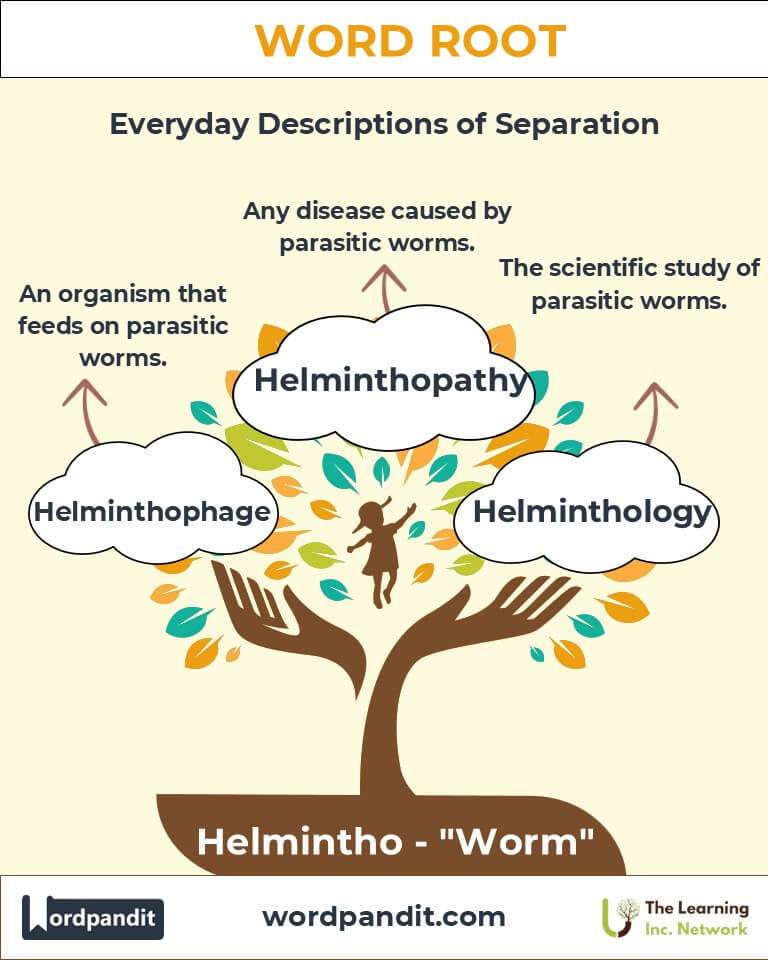Helmintho: The Root of Worms in Science and Medicine
Discover the intriguing world of the word root "helmintho," derived from the Greek word helminthos, meaning worm. This root forms the basis of terms that delve into parasitology, medicine, and biology, such as helminth and helminthology. Explore how this root connects to critical studies of parasitic organisms and their impact on health and ecosystems.

Table of Contents
- Introduction: The Essence of Helmintho
- Etymology and Historical Journey
- Mnemonic: Unlocking the Power of Helmintho
- Common Helmintho-Related Terms
- Helmintho Through Time
- Helmintho in Specialized Fields
- Illustrative Story: Helmintho in Action
- Cultural Significance of Helmintho
- The Helmintho Family Tree
- The Helmintho FAQs
- Test Your Knowledge: Helmintho Mastery Quiz
- Conclusion: The Living Legacy of Helmintho
Introduction: The Essence of Helmintho
The root helmintho unveils a microscopic world of worms that impact human and animal health. Derived from the Greek word helminthos (worm), this root underpins the vocabulary of parasitology and medicine. Words like helminth (parasitic worm) and helminthology (the study of parasitic worms) are vital for understanding the biology and treatment of these organisms, which affect millions worldwide.

Etymology and Historical Journey
Helmintho traces its origins to the Greek helminthos, referring to worms broadly. In ancient medicine, worms were considered harbingers of disease, and early texts documented their effects on health. Over centuries, scientific advancements refined the study of parasitic worms, giving rise to helminthology as a specialized discipline in the 19th century.
Mnemonic: Unlocking the Power of Helmintho
To remember helmintho, picture a worm coiled around a microscope, symbolizing the study of parasitic organisms.
Mnemonic Device: "Helmintho helps scientists uncoil the mysteries of parasitic worms."
Common Helmintho-Related Terms
- Helminth (hel-minth): A parasitic worm, such as a roundworm, tapeworm, or fluke.
Example: "The patient was diagnosed with a helminth infection after consuming contaminated food." - Helminthology (hel-min-thol-uh-jee): The scientific study of parasitic worms.
Example: "Helminthology has advanced treatments for tropical diseases caused by parasitic worms." - Antihelminthic (an-ti-hel-minth-ik): A drug or treatment that targets parasitic worms.
Example: "The doctor prescribed an antihelminthic to eliminate the infection." - Helminthiasis (hel-min-thy-uh-sis): A condition caused by parasitic worms.
Example: "Helminthiasis is prevalent in regions with inadequate sanitation." - Helminthoma (hel-min-thoh-muh): A tumor caused by parasitic worms.
Example: "Helminthoma is rare but highlights the diverse impact of parasitic infections."
Helmintho Through Time
Ancient Context:
In early Greek and Roman texts, worms were linked to plagues and gastrointestinal disorders.
Modern Medicine:
The discovery of antihelminthic drugs in the 20th century revolutionized the treatment of parasitic infections.
Helmintho in Specialized Fields
- Parasitology: Focuses on understanding and combating helminths that impact human and animal health.
Example: "Schistosomiasis, caused by helminths, affects millions in tropical regions." - Veterinary Science: Studies helminth infections in livestock, ensuring animal health and food safety.
Example: "Deworming regimens protect herds from parasitic diseases." - Ecology: Examines the role of helminths in ecosystems, such as regulating host populations.
Example: "Parasites influence predator-prey dynamics in aquatic systems."
Illustrative Story: Helmintho in Action
Dr. Clara, a renowned helminthologist, traveled to a remote village plagued by helminthiasis. Armed with microscopes and antihelminthic drugs, she educated locals about sanitation and provided treatments that reduced infection rates. Her work not only improved health outcomes but also underscored the importance of understanding helmintho-related diseases.
Cultural Significance of Helmintho
Throughout history, worms have symbolized decay and renewal. In literature, parasitic worms often represent corruption, while in science, they highlight the delicate balance between organisms and ecosystems. Helmintho remains a powerful metaphor for transformation and resilience.

The Helmintho Family Tree
- Nema- (Greek: thread): Nematode: A type of roundworm.
Example: "Nematodes are studied in helminthology." - Cesto- (Greek: girdle): Cestode: A tapeworm species.
Example: "Cestodes are common in contaminated food." - Platy- (Greek: flat): Platyhelminth: A flatworm, including flukes and tapeworms.
Example: "Platyhelminths have complex lifecycles."
FAQs About the Helmintho Word Root
Q: What does "Helmintho" mean?
A: The root "helmintho" comes from the Greek word helminthos, meaning "worm." It is used in scientific terms to describe parasitic worms that affect humans, animals, and even plants.
Q: What is helminthology?
A: Helminthology is the branch of biology and medicine that focuses on studying parasitic worms, their life cycles, diseases caused by them, and how to control or treat these infections. It plays a critical role in improving public health, especially in tropical and subtropical regions.
Q: What are antihelminthic drugs?
A: Antihelminthic drugs are medications designed to treat infections caused by parasitic worms. These drugs work by killing the worms directly or by interfering with their ability to reproduce and survive in the host's body.
Q: What is helminthiasis?
A: Helminthiasis refers to a condition or disease caused by infection with parasitic worms. Symptoms depend on the type of worm but can range from mild gastrointestinal distress to severe malnutrition and organ damage in chronic cases.
Q: How do helminths affect ecosystems?
A: Helminths play complex roles in ecosystems by regulating the populations of their hosts. For example, they can limit the overpopulation of certain species, maintain biodiversity, and influence predator-prey dynamics. However, they can also disrupt ecosystems when introduced into non-native environments.
Q: What are examples of helminths?
A: Common examples of helminths include roundworms (e.g., Ascaris), tapeworms (e.g., Taenia), and flukes (e.g., Schistosoma). These worms have complex life cycles and can infect humans, animals, or plants depending on the species.
Q: Why is helminthology important?
A: Helminthology is vital for understanding parasitic worm infections that disproportionately affect developing countries. It contributes to controlling diseases such as schistosomiasis and soil-transmitted helminth infections, improving global health and livelihoods.
Q: What are platyhelminths and nematodes?
A: Platyhelminths, or flatworms, include organisms like flukes and tapeworms, which are typically flat-bodied and have no body cavity. Nematodes, or roundworms, are cylindrical worms with a complete digestive system. Both are significant groups of helminths studied in helminthology.
Q: What are zoonotic helminths?
A: Zoonotic helminths are parasitic worms that can be transmitted between animals and humans. Examples include the tapeworm species Echinococcus, which can cause hydatid disease, and certain nematodes like Toxocara.
Q: How can helminthiasis be prevented?
A: Preventing helminthiasis involves improving sanitation, avoiding contaminated food and water, using protective footwear in endemic areas, and deworming programs. Education about hygiene and transmission pathways is also crucial in reducing infections.
Test Your Knowledge: Helmintho Mastery Quiz
1. What does the root "helmintho" signify?
2. Which term describes a condition caused by worms?
3. What is helminthology?
4. What does antihelminthic mean?
5. What is an example of a platyhelminth?
Conclusion: The Living Legacy of Helmintho
The root helmintho connects language to the critical study of parasitic worms and their profound impact on health and ecology. From ancient texts to modern medicine, this root has shaped our understanding of biology and disease. As research continues, helmintho remains a cornerstone of parasitology, inspiring efforts to combat infections and improve global health.












